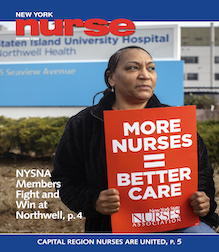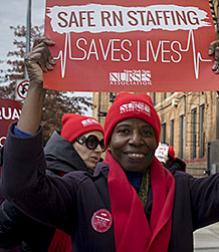
Many envision nurses as gentle angels floating along hospital corridors dishing out pills and pillows while offering patients soothing words and support. The reality is that today’s nurse is more like a tightly wound machine. We dart from patient to patient, computer to pyxis, phone to tablet. We handle checklists and regulatory forms, look up meds and treatments, question doctors, and procure supplies. Amidst it all, we deal with complex patients and complicated family situations and must document so much material that the essence of who we are and what our patients truly need often gets lost.
We rarely take time to ask ourselves important questions like what kind of nurses do we want to be? Is it possible to find real fulfillment in our work if we don’t have the support we need to make a fundamental difference in the lives of our patients and the health of our communities? What’s needed to rejuvenate the profession so that the next generation will be drawn to nursing and make it a career?
The future of nursing and the role of our union
As practicing nurses, we know exactly what’s needed if our profession is to survive and thrive. And we know that our needs are not pipedreams. When we develop bargaining proposals, our needs inform our proposals, and our
contracts make them actionable:
- Real safe staffing — enforceable nurse to patient ratios and staffing based on acuity.
- A healthcare system that supports patients and places community needs ahead of profits through patient protections and community rights.
- Education and training — to ensure that we are equipped with the skills and knowledge needed to provide the best patient care through paid in-service training, continuing education, and tuition support.
- Respect, support and compassion from our employers for the work we do through proper scheduling; adequate salaries and benefits; non-punitive approaches to addressing the conflicts that sometimes arise between family and job demands; and other tools to manage our work-life balance.
- A safe environment including protection from preventable exposure to toxins, violence and injuries through engineering controls, proactive preventive measures, and defined channels for support when injuries do occur.
- Involvement of front line caregivers in defining our practice needs through workplace committees that guarantee direct caregivers a voice and a measure of control over care delivery.
So what’s the problem?
Why do our employers resist us so forcefully when what we seek not only strengthens our profession and protects patients but helps the bottom line, as well? It seems so obvious that everyone wins when nurses voices are listened to: turnover is reduced, outcomes improve, performance indicators rise, and facilities’ reputations benefit. Wouldn’t one think it prudent and rational to include the input of those on the front line when developing work structures and systems? Yet how many times have we seen new practice models introduced only to be dismissed, units built and subsequently torn down, or millions of dollars spent on the latest module or technology only to see it crash and burn?
Power
The bottom line is that there is an intense power struggle going on every day between the workers and the employers. This is true in all industries and health care is no exception. This struggle is amplified during negotiations. Our employers state time and again that they are in charge and have absolutely no interest in sharing control, regardless of our “professional” status. They may tout “shared governance” rhetoric, but at the end of the day, talk is cheap. Our contracts are what give us our voice and our power.
Why we fight
At present, 20,000 NYSNA nurses are engaged in bargaining, some negotiating a first contract and others renewals. What we all share is a vocation to care for those in need. When our bosses impose conditions that impede our ability to do our jobs to our professional standards, we have an obligation to fight back. Sometimes this takes the form of a job action like picketing; other times outreach to the public and media; and in the most serious situations, it may even require a strike. Silence and complacency yield nothing but support for the status quo. The courage to engage in concerted actions, as challenging and inconvenient as they may be, is all that we have, really, to advocate for our patients, our families and ourselves.




